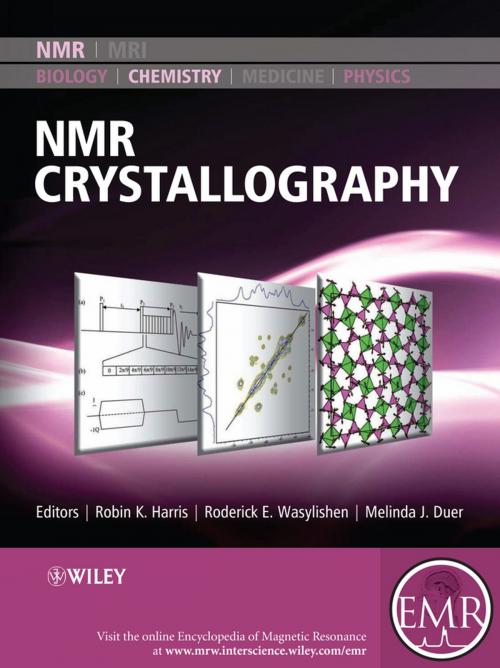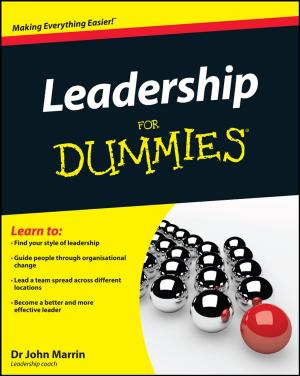| Author: | ISBN: | 9781118587324 | |
| Publisher: | Wiley | Publication: | December 19, 2012 |
| Imprint: | Wiley | Language: | English |
| Author: | |
| ISBN: | 9781118587324 |
| Publisher: | Wiley |
| Publication: | December 19, 2012 |
| Imprint: | Wiley |
| Language: | English |
The content of this volume has been added to eMagRes (formerly Encyclopedia of Magnetic Resonance) - the ultimate online resource for NMR and MRI.
The term "NMR Crystallography" has only recently come into common usage, and even now causes raised eyebrows within some parts of the diffraction community. The power of solid-state NMR to give crystallographic information has considerably increased since the CPMAS suite of techniques was introduced in 1976. In the first years of the 21st century, the ability of NMR to provide information to support and facilitate the analysis of single-crystal and powder diffraction patterns has become widely accepted. Indeed, NMR can now be used to refine diffraction results and, in favorable cases, to solve crystal structures with minimal (or even no) diffraction data. The increasing ability to relate chemical shifts (including the tensor components) to the crystallographic location of relevant atoms in the unit cell via computational methods has added significantly to the practice of NMR crystallography. Diffraction experts will increasingly welcome NMR as an allied technique in their structural analyses. Indeed, it may be that in the future crystal structures will be determined by simultaneously fitting diffraction patterns and NMR spectra.
This Handbook is organised into six sections. The first contains an overview and some articles on fundamental NMR topics, followed by a section concentrating on chemical shifts, and one on coupling interactions. The fourth section contains articles describing how NMR results relate to fundamental crystallography concepts and to diffraction methods. The fifth section concerns specific aspects of structure, such as hydrogen bonding. Finally, four articles in the sixth section give applications of NMR crystallography to structural biology, organic & pharmaceutical chemistry, inorganic & materials chemistry, and geochemistry.
About EMR Handbooks / eMagRes Handbooks
The Encyclopedia of Magnetic Resonance (up to 2012) and eMagRes (from 2013 onward) publish a wide range of online articles on all aspects of magnetic resonance in physics, chemistry, biology and medicine. The existence of this large number of articles, written by experts in various fields, is enabling the publication of a series of ***EMR Handbooks / eMagRes Handbooks***on specific areas of NMR and MRI. The chapters of each of these handbooks will comprise a carefully chosen selection of articles from eMagRes. In consultation with the eMagRes Editorial Board, the EMR Handbooks / eMagRes Handbooks are coherently planned in advance by specially-selected Editors, and new articles are written (together with updates of some already existing articles) to give appropriate complete coverage. The handbooks are intended to be of value and interest to research students, postdoctoral fellows and other researchers learning about the scientific area in question and undertaking relevant experiments, whether in academia or industry.
Have the content of this Handbook and the complete content of eMagRes at your fingertips!
Visit: www.wileyonlinelibrary.com/ref/eMagRes
View other eMagRes publications here
The content of this volume has been added to eMagRes (formerly Encyclopedia of Magnetic Resonance) - the ultimate online resource for NMR and MRI.
The term "NMR Crystallography" has only recently come into common usage, and even now causes raised eyebrows within some parts of the diffraction community. The power of solid-state NMR to give crystallographic information has considerably increased since the CPMAS suite of techniques was introduced in 1976. In the first years of the 21st century, the ability of NMR to provide information to support and facilitate the analysis of single-crystal and powder diffraction patterns has become widely accepted. Indeed, NMR can now be used to refine diffraction results and, in favorable cases, to solve crystal structures with minimal (or even no) diffraction data. The increasing ability to relate chemical shifts (including the tensor components) to the crystallographic location of relevant atoms in the unit cell via computational methods has added significantly to the practice of NMR crystallography. Diffraction experts will increasingly welcome NMR as an allied technique in their structural analyses. Indeed, it may be that in the future crystal structures will be determined by simultaneously fitting diffraction patterns and NMR spectra.
This Handbook is organised into six sections. The first contains an overview and some articles on fundamental NMR topics, followed by a section concentrating on chemical shifts, and one on coupling interactions. The fourth section contains articles describing how NMR results relate to fundamental crystallography concepts and to diffraction methods. The fifth section concerns specific aspects of structure, such as hydrogen bonding. Finally, four articles in the sixth section give applications of NMR crystallography to structural biology, organic & pharmaceutical chemistry, inorganic & materials chemistry, and geochemistry.
About EMR Handbooks / eMagRes Handbooks
The Encyclopedia of Magnetic Resonance (up to 2012) and eMagRes (from 2013 onward) publish a wide range of online articles on all aspects of magnetic resonance in physics, chemistry, biology and medicine. The existence of this large number of articles, written by experts in various fields, is enabling the publication of a series of ***EMR Handbooks / eMagRes Handbooks***on specific areas of NMR and MRI. The chapters of each of these handbooks will comprise a carefully chosen selection of articles from eMagRes. In consultation with the eMagRes Editorial Board, the EMR Handbooks / eMagRes Handbooks are coherently planned in advance by specially-selected Editors, and new articles are written (together with updates of some already existing articles) to give appropriate complete coverage. The handbooks are intended to be of value and interest to research students, postdoctoral fellows and other researchers learning about the scientific area in question and undertaking relevant experiments, whether in academia or industry.
Have the content of this Handbook and the complete content of eMagRes at your fingertips!
Visit: www.wileyonlinelibrary.com/ref/eMagRes
View other eMagRes publications here















